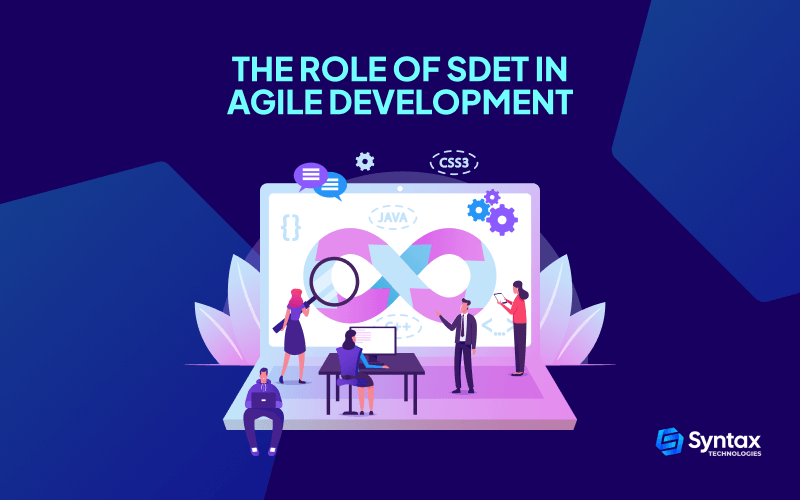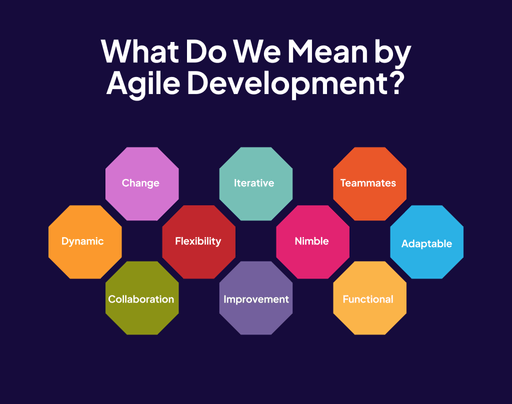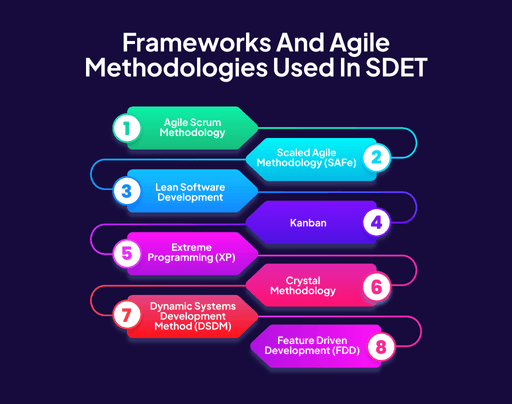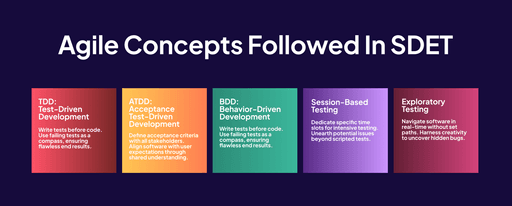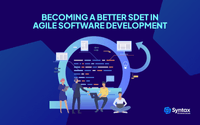Hey there, coding and testing comrades!
Today, let’s dive into the exhilarating world of the SDET in Agile Development.
It’s not just about lines of code and test scripts; it’s about a dynamic dance between development and testing, and SDETs are the maestros orchestrating the symphony in the Agile universe.
Of course, you can’t be agile overnight. However, in the world of test automation, expanding your knowledge of QA automation can do wonders in an era dominated by tech.
So, buckle up for a tech adventure where collaboration meets innovation, and every code commit is a step towards software perfection!
What is Agile Software Development?
Imagine this: instead of a long, meticulous plan carved in stone, Agile is more like a dynamic, ever-evolving roadmap.
In the world of Agile, we embrace change like a favorite playlist. It’s all about collaboration, flexibility, and quick, iterative cycles. We build, test, learn, and repeat a constant loop of improvement that keeps our software nimble and ready for whatever the digital winds may bring!
What are some benefits of agile development methodology?
Think of it as a friendly, adaptable approach where developers and testers aren’t just coworkers; they’re teammates, working side by side to create software that’s functional and perfectly tuned to user needs.
- Flexibility and Adaptability: Agile allows for changes to be made after the initial planning. Regular feedback from users and team members helps in refining the development process.
- Faster Time to Market: By breaking the project into manageable units, the teams can achieve quick wins, fast prototypes, and early error detection and correction, leading to faster product releases.
- Increased User Engagement: Regular check-ins with stakeholders and constant feedback loops keep the project aligned with user needs and expectations, enhancing customer satisfaction.
What are some challenges you might encounter in agile development?
- Less Predictability: Because it is flexible, the final outcome can sometimes be different from the initial requirements, which can lead to scope creep.
- Resource Intensiveness: Agile often requires more time and attention from everyone involved, which can increase the workload and stress on team members.
- Requires Experienced Teams: Without a clear commitment and understanding from all team members, the lack of a structured plan can lead to project disarray and mismanagement.
So, in a nutshell, Agile Development is like a tech-savvy friend who’s always up for a spontaneous adventure, ready to pivot, adapt, and deliver very flexible software.
What of SDETs Do in Agile Development?
Let’s shine a spotlight on the vibrant world of SDETs in Agile Development, where testing meets agility, and every code commit is a big move towards software excellence!
1. Agile Testing Architects
QA Automation in Agile is not just testing; It is like the architects of the testing blueprint. It goes hand in hand with developers, ensuring that testing is seamlessly integrated into the framework of each sprint.
2. Frequent High-Fives with Developers
Collaboration is the name of the game. SDETs high-five developers regularly, sharing insights and working together to ensure each piece of code is functional and quality-checked.
3. Iterative Rhythm Makers
In Agile, it’s all about the rhythm of iterations. SDETs play a crucial role in the iterative process, testing continuously and providing feedback so that the software evolves with each cycle.
4. Adaptable Navigators
Just like navigators adjusting their course in ever-changing waters, SDETs adapt to changes on the fly. Agile development is all about embracing change, and our SDETs are the masters of adapting test strategies as the software evolves.
5. User Advocates
SDETs champion the end-users. They make sure that not only does the code work but it delivers a stellar user experience. After all, happy users are like the applause at the end of a successful performance!
6. Storytellers of Quality
SDETs don’t just find bugs; they tell a story of software quality. Through comprehensive testing and detailed bug reports, they ensure that the final software product is not just functional but shines bright in terms of quality.
7. Continuous Improvement Guides
Agile is a journey of continuous improvement. SDETs are like guides on this journey, constantly refining testing strategies, adopting new tools, and ensuring that the testing process is as agile as the development itself.
Frameworks and Agile Methodologies Used in SDET
Let’s explore Agile methodologies and frameworks, each with its unique personality and style like characters in a tech-savvy ensemble!
Agile Scrum Methodology:
Agile Scrum is a cornerstone of Agile. It revolves around short, concentrated sprints where teams collaborate intensively. Each sprint aims to deliver a valuable piece of software, working together to achieve common goals.
Scaled Agile Methodology (SAFe):
SAFe takes the core principles of Agile and expands them for larger enterprises. It’s designed to get multiple teams in big organizations working in sync and delivering consistently.
Lean Software Development:
Lean emphasizes efficiency. It’s about trimming the fat and ensuring every step in the development process adds real value. The focus is on streamlining processes and eliminating waste.
Kanban:
Kanban is about visual organization. Using a Kanban board, teams can track tasks, visualize workflow stages, and ensure everything progresses efficiently.
Extreme Programming (XP):
XP is about pushing boundaries. It encourages practices like pair programming and continuous integration to improve software quality and responsiveness.
Crystal Methodology:
Crystal is tailored to fit. With variants like Crystal Clear and Crystal Orange, it’s adaptable to various project sizes, ensuring a fit for diverse needs.
Dynamic Systems Development Method (DSDM):
DSDM champions adaptability. It focuses on timely delivery while being flexible enough to accommodate changing requirements throughout the development process.
Feature Driven Development (FDD):
FDD organizes the development around feature sets. It’s about understanding the bigger picture of software functionality and breaking it down into manageable chunks.
All in all, in the world of Agile, each methodology offers a unique approach, ensuring that teams can find the best fit for their specific software development challenges.
Agile Concepts Followed in SDET
Test-Driven Development (TDD):
- Concept: In software, it means writing tests before writing the actual code. It’s a dance of tiny, incremental steps where failing tests guide the agile development process, ensuring the final composition is flawless.
Acceptance Test-Driven Development (ATDD):
- Concept: ATDD is the collaborative brainstorming session before the big reveal. It involves defining acceptance criteria for a feature in collaboration with stakeholders. Developers, testers, and business stakeholders harmonize to create a shared understanding, aligning the agile development process with user expectations.
Behavior-Driven Development (BDD):
- Concept: BDD is a collaborative approach where everyone involved from developers to testers uses a common language to define and understand software behavior. It’s not just code; it’s a shared narrative ensuring everyone’s on the same page.
Session-Based Testing:
- Concept: Testers allocate a specific time, or “session,” to explore and test a feature intensively. It’s like a deep dive into the unknown, uncovering potential issues that might not be apparent through scripted tests.
Exploratory Testing:
- Concept: Exploratory Testing is the adventurous road trip of testing. Testers explore the software, navigating through it in real-time without predefined test cases. It’s like wandering through the landscape, allowing for creativity and adaptability to discover hidden bugs or unexpected behaviors.
In the Agile world of SDETs, these concepts are more than just testing methodologies they are collaborative tools, creative expressions, and a dynamic way of ensuring software quality.
7 Best Practices of SDETs in Agile Development
Let’s delve into the essential best agile practices that make SDETs shine in the dynamic realm of Agile Development!
Collaborative Test Planning:
- Practice: SDETs actively participate in collaborative test planning sessions. They work hand in hand with developers and other stakeholders to define testing strategies, ensuring a shared understanding of the project’s quality goals.
Early Involvement in User Story Refinement:
- Practice: SDETs don’t wait for the script; they’re early birds in user story refinement sessions. By being part of discussions from the start, they contribute their testing insights, helping to shape user stories that are functional and testable.
Automation from the Get-Go:
- Practice: Automation isn’t an afterthought for SDETs; it’s woven into the development fabric. They start building automated test suites from the beginning, ensuring continuous integration and swift feedback loops throughout the Agile iterations.
Continuous Integration and Continuous Deployment (CI/CD) Embrace:
- Practice: SDETs actively contribute to CI/CD pipelines, advocating for and ensuring smooth integration, testing, and deployment of code changes. It’s about keeping the Agile development rhythm flowing seamlessly.
Cross-Functional Collaboration:
- Practice: SDETs break down silos. They collaborate with developers and business stakeholders, QAs, and anyone else involved in the Agile process. It’s a team effort where communication and collaboration take center stage.
Agile Testing Mindset:
- Practice: SDETs embody the Agile testing mindset. They embrace change, adapt quickly to shifting requirements, and view testing not as a phase but as an integral part of the entire agile development lifecycle. Flexibility is their middle name!
Continuous Learning and Adaptation:
- Practice: SDETs are perpetual learners. They stay on the cutting edge of testing tools and methodologies, adapting to new technologies and trends. Continuous learning is not just a practice for them; it’s a way of life in the ever-evolving Agile landscape.
In the hands of skilled SDETs, these best practices become the secret sauce that adds efficiency, collaboration, and excellence to Agile Development. It’s a tech journey where every practice is a step towards software perfection!
Top Strategies to Get Ready for Your Role in Agile Development as an SDET
Certainly! Preparing for your role as a Software Development Engineer in Test (SDET) in Agile Development is an exciting journey.
Here are some top strategies to help you get ready:
Master Agile Principles:
- Strategy: Start by thoroughly understanding Agile principles and values. Familiarize yourself with the Agile Manifesto and its twelve principles. This foundation will guide your mindset and approach in an Agile environment.
Deep Dive into Agile Methodologies:
- Strategy: Explore various Agile methodologies like Scrum, Kanban, and XP. Understand how each methodology operates, their ceremonies, roles, and how testing integrates into each. This knowledge will be crucial for adapting to the Agile workflow.
Learn About Your Team:
- Strategy: Agile is all about collaboration. Get to know your development team members, product owners, and other stakeholders. Understanding their roles, expectations, and communication styles will facilitate smoother collaboration.
Sharpen Your Automation Skills:
- Strategy: Automation is a cornerstone of SDET roles. Strengthen your skills in test automation frameworks, tools, and scripting languages like Selenium, JUnit, TestNG, or others relevant to your tech stack. Practice creating robust and maintainable automated test suites.
Embrace Test-Driven Development (TDD):
- Strategy: Familiarize yourself with Test-Driven Development. Understand the TDD cycle of writing a test, making it pass, and then refactoring. This approach is fundamental in Agile development and ensures that code is thoroughly tested from the outset.
Understand Continuous Integration/Continuous Deployment (CI/CD):
- Strategy: CI/CD pipelines are the heartbeat of Agile development. Learn how these pipelines work and understand your role in contributing to them. Explore tools like Jenkins, Travis CI, or GitLab CI to automate testing and deployment processes.
Adopt Behavior-Driven Development (BDD):
- Strategy: BDD is a collaborative approach to software development. Learn to write and execute BDD scenarios using tools like Cucumber or SpecFlow. This helps in creating a shared understanding among team members about the expected behavior of the software.
Practice Agile Testing Techniques:
- Strategy: Agile testing goes beyond traditional testing methods. Practice techniques like exploratory testing, session-based testing, and acceptance test-driven development (ATDD). These approaches are integral to ensuring comprehensive testing in an Agile environment.
Stay Current with Industry Trends:
- Strategy: The tech world evolves rapidly. Stay updated with the latest Agile development and testing trends, tools, and best practices. Follow industry blogs, attend webinars, and participate in relevant communities to stay in the loop.
Take Comprehensive Courses:
- Strategy: Consider enrolling in comprehensive courses offered by reputable institutions or online platforms. Syntax Technologies provides courses tailored for QA Automation Engineers entering the Agile landscape.
By combining these strategies, you’ll not only be well-prepared for your role as an SDET in Agile Development but also set yourself up for a rewarding and impactful career in the dynamic world of software development.
Becoming a Better SDET in Agile Software Development
And there you have it, my friends, the Agile adventure through the lens of a Software Development Engineer in Test (SDET).
We’ve explored the dynamic world of methodologies, the harmonious collaboration of concepts, and the best practices that make SDETs the maestros of Agile development.
As we wrap up this journey, remember that to be an SDET is not just a job; it’s a journey of continuous learning, collaboration, and adapting to the ever-evolving tech landscape.
Each line of code, each test script, and every collaborative effort is a step toward mastering the art of Agile development.
And guess what? If you’re eager to embark on this exciting journey, Syntax Technologies is your ultimate companion!
Offering comprehensive courses led by industry experts, Syntax Technologies equips you with the skills, knowledge, and hands-on experience needed to kickstart your career as a professional SDET in Agile development.
So, whether you’re a coding novice or a seasoned developer looking to enter the world of test automation, Syntax Technologies has your back.
Join us, and let’s turn your tech dreams into reality!
